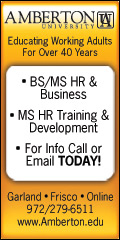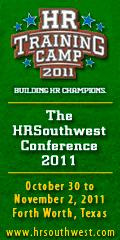HR Matters
Texas SHRM
The HRSouthwest Conference is the largest regional HR conference in the U.S. The conference offers world-renowned keynote speakers, two-and-a-half days of educational sessions, networking opportunities and so much more. Register today!
The SHRM Pinnacle Award Program is designed to honor SHRM affiliates for high-level development and contributions that enhance the development of effective human resource management. All SHRM chapters and state councils are eligible to submit applications. Up to seven $1,000 Pinnacle Awards will be made to chapters and up to two $1,000 Pinnacle Award will be awarded to state councils. In addition to the awards and monetary grants, this impressive program provides increased prestige among your peers and enhanced recognition in the human resource industry. The 2011 Pinnacle Award Information Packet and application form are now available.
We hope to see all of the members of the SHRM-Texas State Council at our next meeting on Saturday, October 29 in Fort Worth. Log on to www.texasshrm.org for details and to register!
Fall Registration Opened on August 1 Registration Deadline: September 30, 2011
Encourage graduating students to register for SHRM’s Assurance of Learning Assessment. It is the new universal benchmark for graduate and undergraduate level HR students. The Assurance of Learning assessment will help distinguish students applying for entry-level HR positions. When a student passes the exam, he or she will receive a certificate of learning that informs hiring managers that the student has sufficient knowledge to enter the workforce. Registration opened on August 1 for the October 15- November 15 testing window. Hiring managers can expect to start seeing this achievement on recent graduates’ resumes starting summer 2011. Visit http://www.shrm.org/assessment for more information.
Employee Benefit News' Benefits Forum and Expo is the largest event in the nation solely dedicated to employee benefits. In its 24th year, BF&E continues to be the event of choice for senior benefit professionals in America. The 2011 event convenes September 25-27, 2011, in Dallas and is dedicated to helping you reach a brighter benefits horizon. We will provide you with insight into new benefits products and services and forward-looking trends. Insightful keynote presentations, concurrent tracks of sessions, peer-to-peer dialogs and the opportunity to earn continuing education credits make this the most relevant and valuable event you’ll attend this year. SHRM members are receiving a special discounted rate of $495 for this event. We invite you to log on to http://www.benefits-forum.com/ for details and use this link to register at the discounted rate.
The 2011 HR Summit, was held Tuesday, August 16 at the Hunter Welcome Center at Abilene Christian University. The theme was "Peace, Love & HR." The program speakers and topics included Al Lucia, CSP and president of ADL Associates, whose presentation was "Employee Engagement and Effective People Practices."
Representatives from the Texas Workforce Commission and Workforce Solutions of West Central Texas presented "Tips for Texas Employers," which focused on assistance for Texas small businesses
Joey Cope of the Duncum Center for Conflict Resolution at Abilene Christian University presented "The Human Resources Professional as Facilitator Using Communication and Conflict Resolution Techniques in Daily Interactions with Employees," and Randy Anderson of E3 Professional Trainers presented "12 Rules of Pursuing Personal Excellence."
The partners for this year's conference were the Office of the Governor and Texas Workforce Solutions. The event was pre-approved by HRCI for 6.75 CEUs and included door prizes and lunch with State Representative Susan King who covered an update of the Texas Legislative Session. We had 113 attendees, which was about a 25 percent increase from last year's attendance. Great work, Big Country SHRM!
The U.S. Department of Labor (DOL) is making $1.6 million available in a second round of funding for an initiative designed to increase the ability of companies—especially those that are minority owned and operated—to hire people with disabilities.
Labor Secretary Hilda L. Solis made the announcement at the National Disability Forum on Aug. 4, 2011, in Washington, D.C., which focused on strategies to increase employment opportunities in the small business community for people with disabilities.
The forum drew representatives from the Society for Human Resource Management (SHRM), business, government and other organizations.
"The Labor Department is committed to ensuring that every American who wants a job can find one, including people with disabilities," Solis said. The funding is for the Add Us In program, a DOL Office of Disability Employment Policy initiative that launched in 2010. One of its goals is to create business engagement models that can be replicated nationally.
Cooperative Agreements
The money will fund up to three cooperative agreements, with allotments ranging from $500,000 to $550,000. The application deadline is Sept. 2, 2011.
"We can’t spare anyone’s talent," Solis said. "People with disabilities can and do want to work; in fact, there’s a growing body of evidence that workers with disabilities meet or exceed [performance standards]."
Solis emphasized the need for work flexibility options and accommodations.
"If we make modest accommodations, we can see their talent unleashed," she said about persons with disabilities.
Providing those accommodations costs much less than employers think, noted Eric C. Peterson, manager, diversity and inclusion, at SHRM.
Peterson was among the panelists speaking during a morning plenary session that looked at trends in small business growth, demographics and disability. Also on the panel were Ivonne Cunarro, Minority Business Development Agency, and Terence McMenamin, U.S. Bureau of Labor Statistics.
"We really need to reframe what we think an accommodation is. They are not special things for special people," Peterson said. He pointed out, for example, that a shopping cart is an accommodation that makes up for the limitation of what two arms can carry.
Peterson said organizations looking to recruit and hire problem solvers would do well to consider persons with disabilities.
"People with disabilities are actually ready-made with that innovative thinking that organizations really need" because they have had to adapt and solve problems that others have not faced.
These bring fresh approaches, ideas and perspectives to workplace teams, Peterson said. He offered employers the following advice in becoming an employer of choice for workers with disabilities: Provide accommodations happily. Don’t lower performance standards. Recruit the best talent in whatever packaging that talent arrives. Provide access to tools, resources, information, equipment and career options. Plan for career development and advancement. Build an inclusive culture by educating everyone in the organization, not just recruiters and supervisors, about the organizational value of diversity.
"Create a culture in your organization where people can be themselves in lots of ways. They can bring their whole selves to work... rather than [fulfill] just a role on an organizational chart."
Kathy Gurchiek is associate editor for HR News. She can be reached at kathy.gurchiek@shrm.org.
The Genetic Information Nondiscrimination Act (GINA) generally prohibits employers from requesting, requiring or purchasing genetic information. However, the act sets forth specific exceptions to that prohibition, one of which allows an employer to acquire genetic information about an employee or that employee’s family members when the employer offers a wellness program to employees on a voluntary basis. In June 2011, the Equal Employment Opportunity Commission (EEOC) provided guidance—in the form of an opinion letter—on certain issues affecting workplace wellness programs.
The letter, which addresses issues related both to GINA and to the Americans with Disabilities Act (ADA), responds to a specific request to the EEOC to make clear that offering incentives for participation in a wellness program does not violate GINA or the ADA, and asking for assurance that family medical history that is voluntarily provided by employees in a wellness program may be used to guide employees into disease management programs.
The EEOC begins the opinion letter by pointing out that it classifies wellness programs as "voluntary" medical exam/activity, and that Title I of the ADA allows employers to conduct "voluntary" medical exams – specifically those including obtaining medical histories – so long as any medical information obtained is kept separate and apart from personnel records. However, the EEOC has not taken a position (and declined to do so in the opinion letter) on whether the ADA allows an employer to offer financial incentives for employees who participate in wellness programs that include disability-related inquiries or medical examinations.
The EEOC’s opinion letter states that GINA allows an employer to use genetic information voluntarily provided by an employee in order to "guide that individual into an appropriate disease management program." However, the letter also spells out parameters related to the gathering and compilation of information for such programs. First, an employer coordinating a wellness program must obtain prior voluntary and knowing authorization from an employee, in writing, before acquiring genetic information for the program. Further, according to the EEOC’s opinion letter, any individually identifiable genetic information provided under the wellness program exception is available only for purposes of such services in aggregate terms that do not disclose the identity of specific individuals. Finally, an employer may not offer any financial inducement for individuals to provide genetic information for purposes of a wellness program. However, the wellness program may offer financial inducements for completion of health risk assessments that include questions about family medical history or other genetic information, provided the covered entity makes clear, in language reasonably likely to be understood by those completing the health risk assessment, that the inducement will be made available whether or not the participant answers questions regarding genetic information. In other words, if the assessment contains a mix of questions, certain of which are related to genetic information, any financial incentive paid to employees for participation in the assessment must be paid regardless of whether the individual answers the genetic information questions or not.
While an opinion letter from the EEOC does not have the force of law and does not typically receive the deference of a federal regulation, such letters are of interest to knowledgeable employers. As more and more companies begin to develop and institute wellness programs for employees, it is important to understand the way in which these programs will be viewed by the government agencies charged with regulating and assuring nondiscrimination in their implementation.
Maria Greco Danaher is an attorney with the firm of Ogletree Deakins in Pittsburgh.
Editor’s Note: This article should not be construed as legal advice.
SHRM SHAPE Membership Goals Updated!
In case you haven’t heard, SHRM has revised its SHAPE membership targets for 2011: Membership Star: 0% - 2.9%; Membership Superstar: 3%+. This is a relief!
Engagement
Now that some pressure has been removed from the member recruiting side, let’s take some time to consider member engagement. Please consider an engagement survey to determine your chapter membership needs. If an online or paper survey is out of the question, then ask for time at your next board meeting to discuss the level of membership engagement. At a recent meeting, SHRM’s director of member engagement suggested reading Maximum Engagement by C. David Gammel. This book may offer some inspiration for you and your board.
Texas Membership Conference Call
We recently held a conference call for chapter membership leaders. Thank you to those who called in! We discussed membership engagement, shared challenges, and success stories. Most chapters are working on renewals this fall. Please let me know how I can help. SHRM Membership Webinar 9/21 & 9/22. An email with instructions will be sent by SHRM. Please contact Jennifer Rower at 210-638-5012 or jrower@woodcharter.com for assistance.
Like many HR Professional’s, Minerva Navarette "accidentally fell into a position" as a benefits trainee 13 years ago. Minerva, who shared her story at SHRM Foundation’s Donor Appreciation Breakfast during the SHRM Annual Conference in June, is a two-time scholarship winner. When she first started in her position, she felt a responsibility "to learn as much as I could about human resources." She soon realized that while the research she did on the SHRM website was helpful, getting a college degree would be what she need to survive in the world of HR. She graduated in 2004 with a Bachelor of Science in human services management. Four years later, as a newly single parent, Minerva received her MBA. In 2010, a SHRM Foundation advertisement in HR Magazine inspired Minerva to apply for a scholarship. She received her first scholarship to pursue a doctoral degree in organizational leadership. The second scholarship is helping in her efforts to obtain SPHR certification. For this, Navarette is extremely grateful, adding, "I can honestly say SHRM and the Foundation will continue to be an integral part of my future success." Minerva is now a director of human resources in Las Vegas and is currently working towards her SPHR certification. If your state council has not yet given, we encourage you to do so as soon as possible.
Without the continued support of SHRM state councils and chapters, the Foundation would not be able to provide as many services as we do to the HR profession. Help others like Minerva reach for the stars; please donate today. Visit www.shrm.org/foundation.
Please plan to join us for the next Veterans Symposium on Wednesday, September 28 in Houston. For more details log on to http://www.texasshrm.org.
At a recent leadership development training program, I asked a question I regularly ask: Knowing what you know now, how many of your current employees would you re-employ?
Answer: about 60 percent.
This answer is consistent with previous groups I have trained, as well as general employment survey research. It means that poor employee selection decisions are regularly made. Suitable candidates are not being found. About 40 percent of employees are not performing well or as expected. In some way, they cause their management a problem. It may be poor attitude or interpersonal problems. It may be they cannot perform their duties properly. Are sound employee selection practices worth the effort?
In time management programs, I sometimes cite recruitment and selection as a good example of the "Pareto principle"—20 percent of the effort produces 80 percent of the results. It is worth a little extra effort to make a good selection rather than an average one. Spending the time to make a good decision is a sound investment. It is time well spent.
Managing performance problems is a constant theme raised by training participants. Amongst other things, poor performance consumes management time. It diverts attention away from more productive matters. Managing performance would not be a major issue if team leaders and managers exercised greater control in the recruitment and selection process.
Employee Selection Tips
The following tips may help:
• Establish clear requirements - what is expected of the position, what are the knowledge, skills and attitudes required to carry out the position responsibilities effectively?
• Probe the candidates in a variety of ways - ask what he or she would have done/would do in a variety of situations, test knowledge, seek demonstration of actual skills.
• Consider how they complement the other team members - what different attitudes and approaches do they bring?
• Make sure you are fully satisfied - a partially suitable candidate will only cause problems in the long run.
I apologize for listing such 'basic' tips. On the face of it, these tips seem relatively straightforward. However, doing them correctly is not easy. For example, thinking about appropriate and non-standard interview questions requires some time. Most candidates should have a coherent answer to:
• What are your strongest points?
• What are your weaknesses?
Behavioral questions are more helpful:
• What would you do if...?
• How have you approached... before?
Interviews are not the only thing to rely on; there are other selection techniques, as well.
Conclusion
The number of times I talk to managers and team leaders about performance problems, and discover that the problems existed from the very start, prompts me to reinforce the basics. Remember, team leaders and managers consistently rate their own performance (or their organizations) at only a 60 percent employment success rate. Successful employment practices rely on getting the basics right. It takes a little extra effort and some extra time, but that effort is well rewarded. An efficient and effective employee saves time and contributes positively to organizational success. A poor employment selection only brings problems and stress—even if the person leaves smoothly.
Derek Stockley provides training, learning and performance management consulting services from his base in Melbourne, Victoria, Australia. He conducts a one-day recruitment and selection course in Melbourne as well as in-house training in job search and selection and interviewing. For more information, visit www.derekstockley.com.



